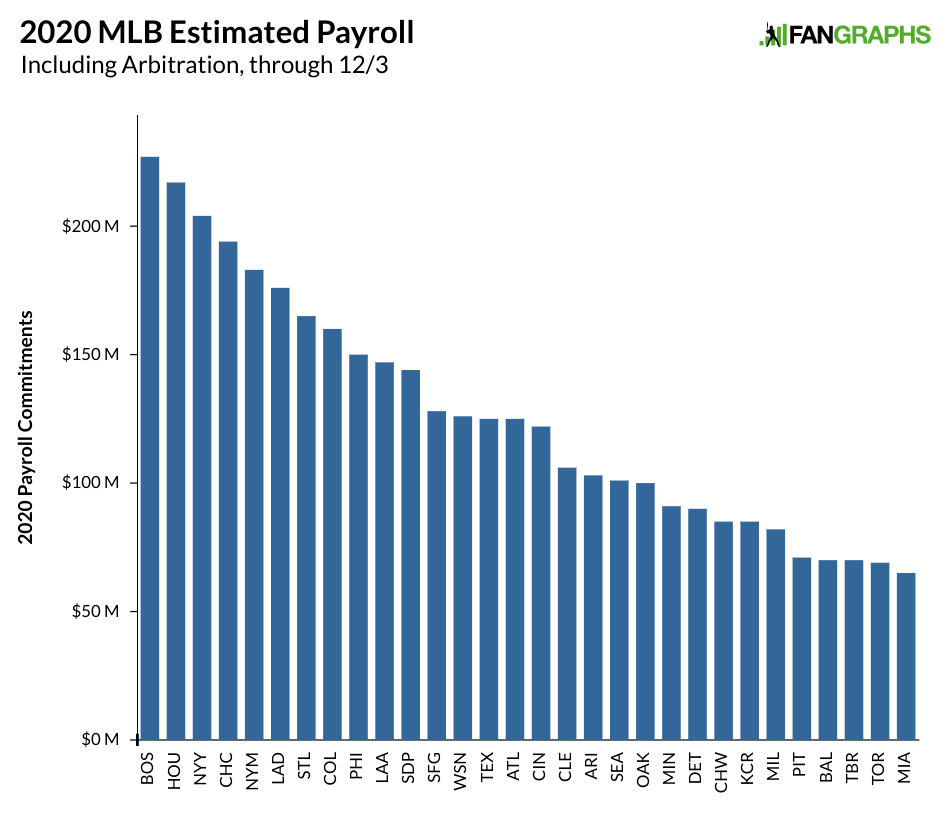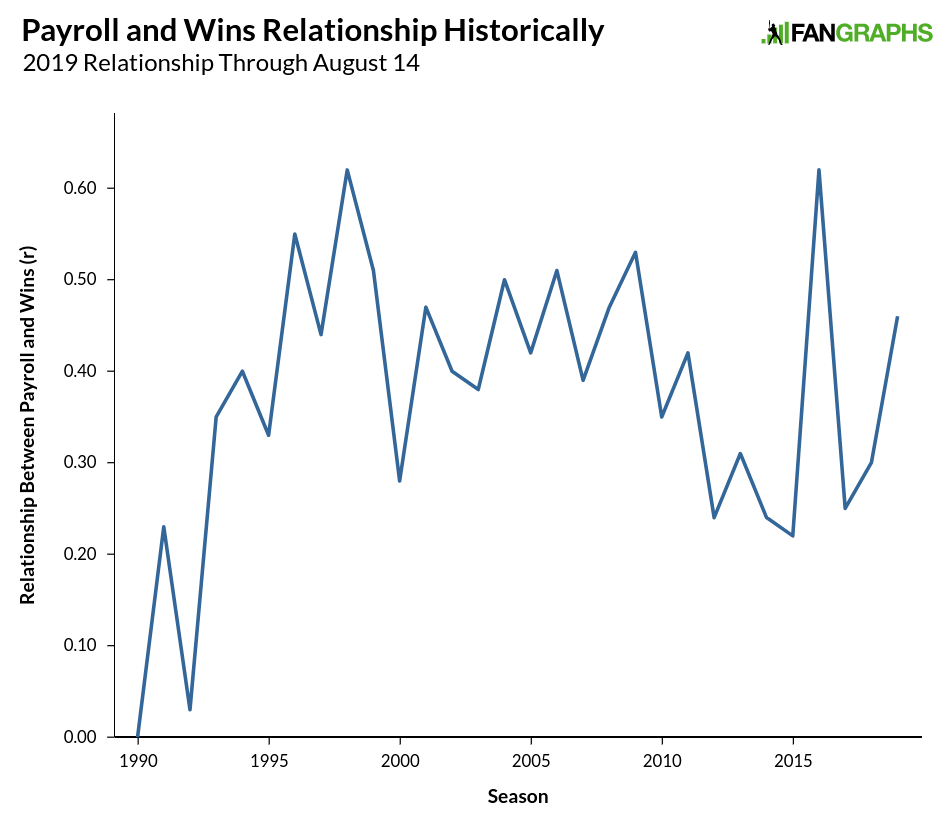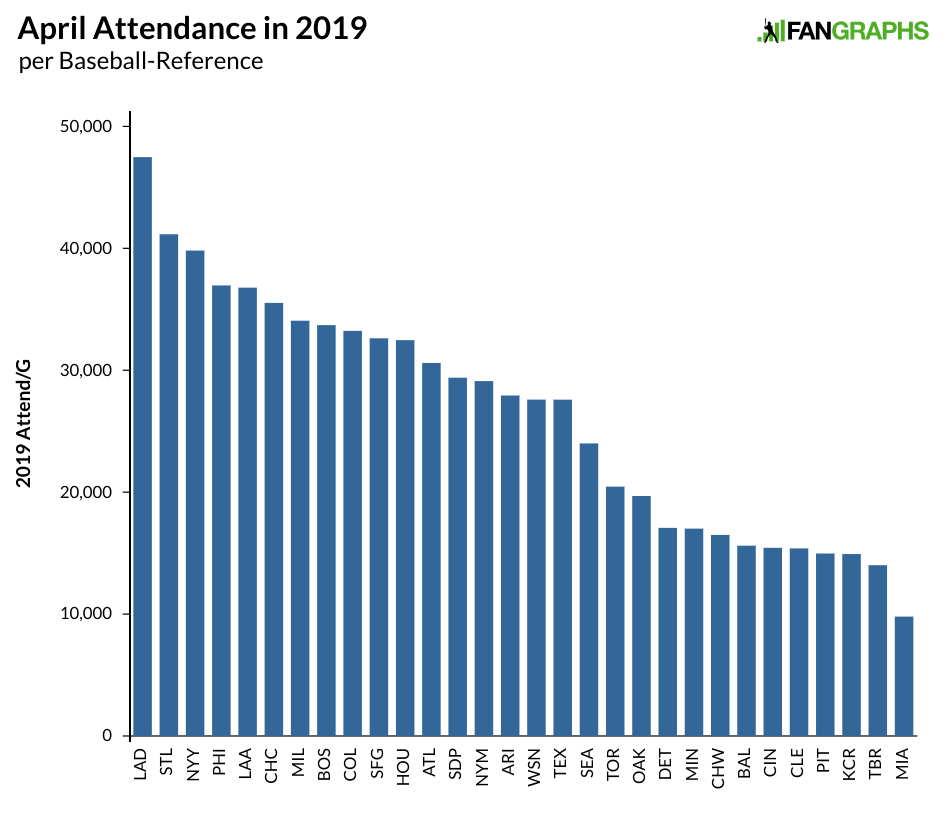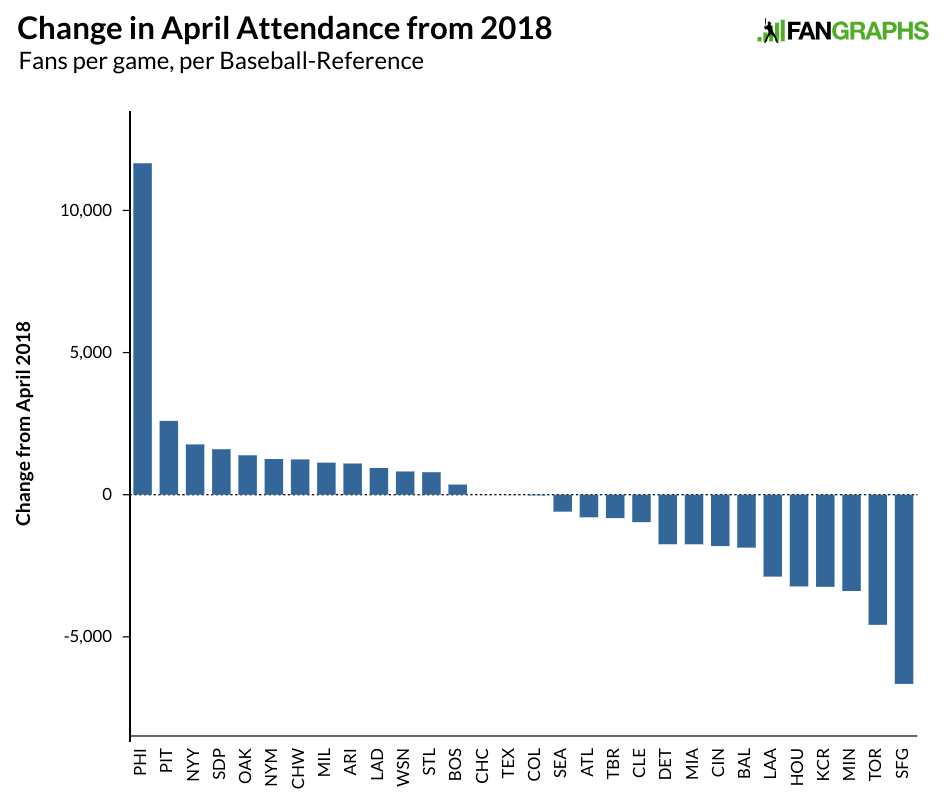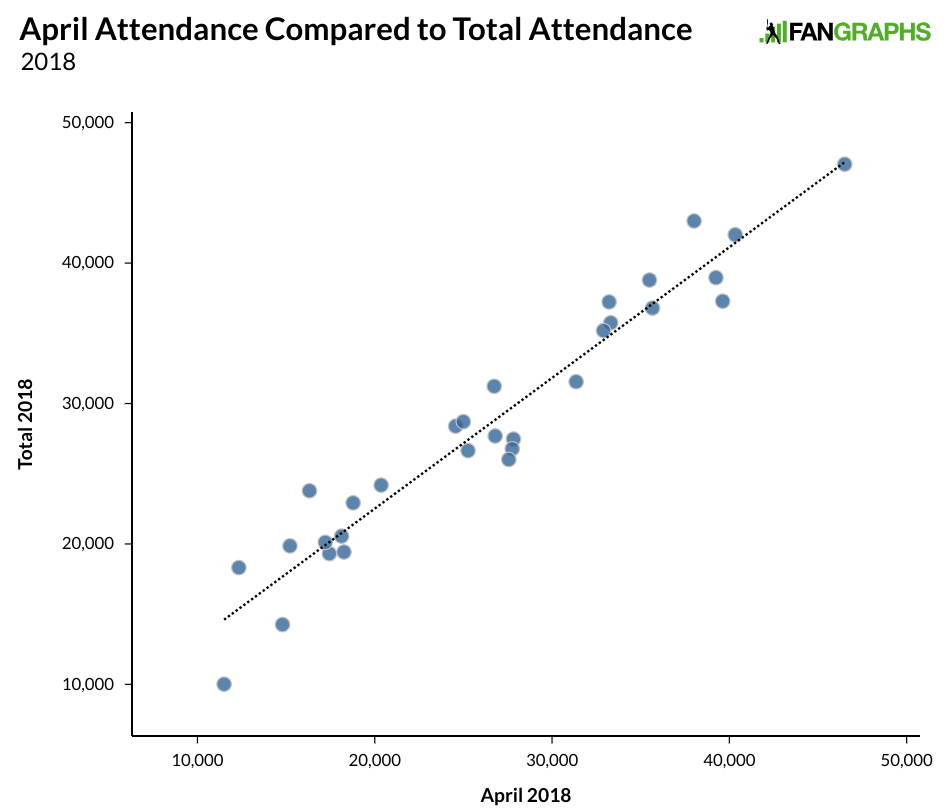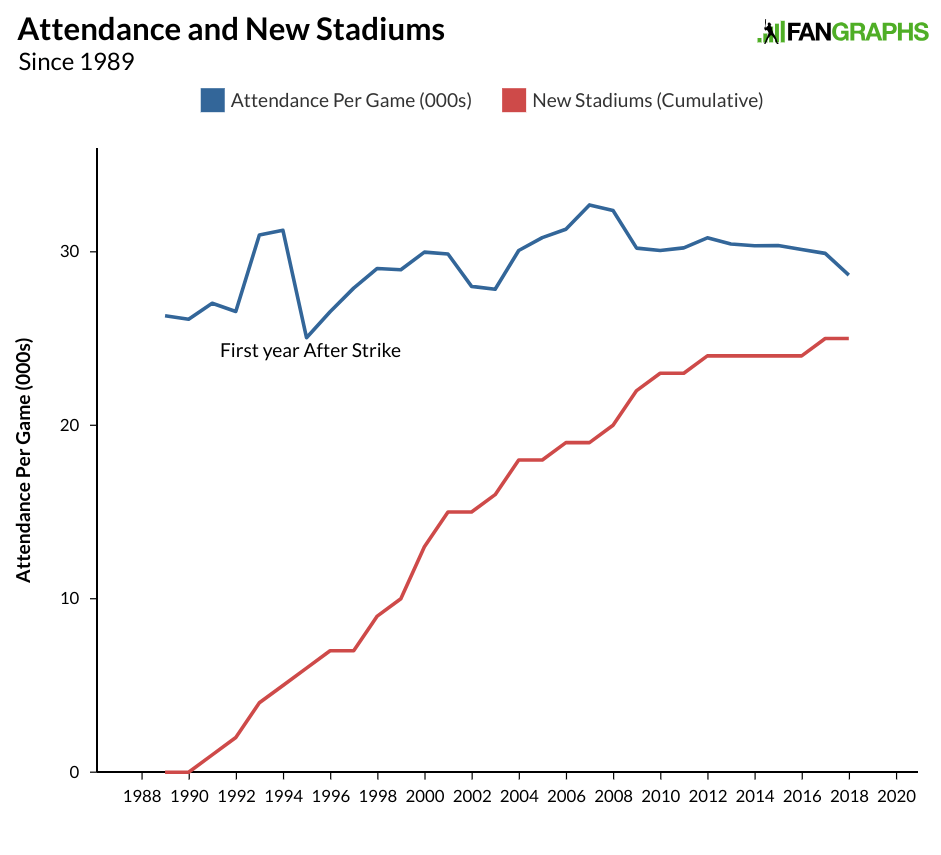We don’t know exactly why Dallas Keuchel and Craig Kimbrel didn’t sign with teams during the winter and early spring like the other prominent free agents did. It’s possible that early posturing around large contract demands pushed some teams away and caused them to explore other options. It’s possible there were just too many teams that weren’t sufficiently interested in adding good players at a reasonable cost, even if Keuchel and Kimbrel’s demands had come down. We do know that neither signed before the season, or in April, and that coming up on the end of May, both players are still looking for a team.
What we might have heard over the last few months is that teams are waiting until after the draft in June to sign Keuchel or Kimbrel so as to avoid losing a draft pick. Over the last decade, as the game has gotten younger and younger players have gotten cheaper relative to veterans, teams have placed greater emphasis on draft picks. Ahead of the last CBA, one of the bigger issues for players was the free agentcompensation system, in which teams made qualifying offers to free agents and then received a first round pick (or something close to it) when those free agents signed elsewhere. One of the major changes in the new CBA was a change to that system designed to make free agents more attractive by lessening the penalty for signing free agents attached to a qualifying offer. While Keuchel and Kimbrel aren’t ironclad proof the system didn’t work, they are a couple of key pieces of evidence. A breakdown of the penalties provides further reasoning.
To understand why the system hasn’t worked, it helps to look at the penalties. Here are the rules from MLB:
Any team that signs a player who has rejected a qualifying offer is subject to the loss of one or more Draft picks. However, a team’s highest first-round pick is exempt from forfeiture, which is the most notable change that went into affect with the new system. Three tiers of Draft-pick forfeiture — which are based on the financial status of the signing team — are in place to serve as a penalty for signing a player who rejected a qualifying offer:
• A team that exceeded the luxury tax in the preceding season will lose its second- and fifth-highest selections in the following year’s Draft, as well as $1 million from its international bonus pool for the upcoming signing period. If such a team signs multiple qualifying-offer free agents, it will forfeit its third- and sixth-highest remaining picks as well.
Examples: A team with one pick in each round of the 2019 Draft would lose its second- and fifth-round picks. A team with two first-round picks and one pick in each subsequent round would lose its second-highest first-round pick and its fourth-round pick.
• A team that receives revenue sharing will lose its third-highest selection in the following year’s Draft. If it signs two such players, it will also forfeit its fourth-highest remaining pick.
Examples: A team with one pick in each round of the 2019 Draft would lose its third-round pick. A team with two first-round picks and one pick in each subsequent round would lose its second-round pick.
• A team that neither exceeded the luxury tax in the preceding season nor receives revenue sharing will lose its second-highest selection in the following year’s Draft, as well as $500,000 from its international bonus pool for the upcoming signing period. If it signs two such players, it will also forfeit its third-highest remaining pick and an additional $500,000.
Examples: A team with one pick in each round of the 2019 Draft would lose its second-round pick. A team with two first-round picks would lose its second-highest first-round pick.
Determining exactly which picks can be forfeited is a little tricky, as essentially all picks count when determining a team’s second, third, or fourth pick, but compensatory picks from not signing a player the previous season, as well as the market/revenue picks at the end of the first and second rounds, are not subject to forfeiture. That said, since the market/revenue comp picks can be traded, if one of those picks is traded to another team, it is no longer protected. For example, Oakland was awarded the 40th pick in this year’s draft. That pick would have been a protected pick for the club, but since they traded it to Tampa Bay in the Jurickson Profar deal, it becomes subject to potential forfeiture for the Rays if they were to sign Dallas Keuchel or Craig Kimbrel.
To provide concrete examples, the table below shows the pick every team would give up for signing Keuchel or Kimbrel right now, along with the slot value for that pick (which can be found here), and the present value of the pick based on my research. Also included is the value of the international money penalty based Kiley McDaniel’s research, with one dollar of international spending estimated at five times that amount in value.
A note about this table: Houston and Boston are assumed to sign their own free agent, and thus not get a compensatory pick, which is the value listed below. In reality, that pick is now worth considerably less, as it is far less likely to happen. If Boston or Houston were to sign the other team’s free agents, the cost would be significantly higher.
Penalty for Signing Dallas Keuchel or Craig Kimbrel
|
Pick for FA |
Slot Amount |
Present Value of Pick |
International Value Lost |
Extra Cost of FA |
| NYY |
38 |
$1,952,300 |
$8.1 M |
$2.5 M |
$10.6 M |
| TEX |
41 |
$1,813,500 |
$7.4 M |
$2.5 M |
$9.9 M |
| ARI |
33 |
$2,202,200 |
$9.3 M |
— |
$9.3 M |
| CHW |
45 |
$1,650,200 |
$6.7 M |
$2.5 M |
$9.2 M |
| SFG |
51 |
$1,436,900 |
$5.8 M |
$2.5 M |
$8.3 M |
| TOR |
52 |
$1,403,200 |
$5.7 M |
$2.5 M |
$8.2 M |
| NYM |
53 |
$1,370,400 |
$5.5 M |
$2.5 M |
$8.0 M |
| LAA |
55 |
$1,307,000 |
$5.3 M |
$2.5 M |
$7.8 M |
| TBR |
40 |
$1,856,700 |
$7.6 M |
— |
$7.6 M |
| STL |
58 |
$1,214,300 |
$4.9 M |
$2.5 M |
$7.4 M |
| CHC |
64 |
$1,050,300 |
$4.3 M |
$2.5 M |
$6.8 M |
| PHI |
91 |
$647,300 |
$3.8 M |
$2.5 M |
$6.3 M |
| WSH |
94, 183 |
$884,200 |
$6.3 M |
— |
$6.3 M |
| LAD |
78 |
$793,000 |
$3.8 M |
$2.5 M |
$6.3 M |
| MIN |
54 |
$1,338,500 |
$5.4 M |
— |
$5.4 M |
| PIT |
57 |
$1,243,600 |
$5.0 M |
— |
$5.0 M |
| ATL |
60 |
$1,157,400 |
$4.7 M |
— |
$4.7 M |
| BAL |
79 |
$780,400 |
$3.8 M |
— |
$3.8 M |
| KCR |
80 |
$767,800 |
$3.8 M |
— |
$3.8 M |
| MIA |
46 |
$1,617,400 |
$6.6 M |
— |
$3.8 M |
| DET |
83 |
$733,100 |
$3.8 M |
— |
$3.8 M |
| SDP |
84 |
$721,900 |
$3.8 M |
— |
$3.8 M |
| CIN |
85 |
$710,700 |
$3.8 M |
— |
$3.8 M |
| SEA |
76 |
$818,200 |
$3.8 M |
— |
$3.8 M |
| COL |
100 |
$581,600 |
$3.8 M |
— |
$3.8 M |
| CLE |
101 |
$577,000 |
$3.8 M |
— |
$3.8 M |
| OAK |
104 |
$560,000 |
$3.8 M |
— |
$3.8 M |
| HOU |
79* |
$780,400 |
$3.8 M |
$2.5 M |
$3.8 M |
| MIL |
133 |
$422,300 |
$2.8 M |
— |
$2.8 M |
| BOS |
138* |
$402,000 |
$2.5 M |
— |
$2.5 M |
For no team is the extra cost greater than the amount guaranteed to Matt Harvey this offseason and for half the teams, the cost is around what Daniel Descalso or Jordy Mercer received. These are not large sums. This list isn’t meant to provide a justification for a team signing or not signing any particular free agent, but it does show that there are pretty significant differences in the penalties teams face. The amounts of money we are talking about shouldn’t be the deciding factor in determining whether or not to sign a free agent, and “We are unwilling to forfeit a draft selection to sign Player X” is actually a prohibited phrase under the CBA, whether on or off the record. Teams can and do factor in the value of a draft pick when making an offer. The argument that teams horde draft picks as things to be held at all costs rings false when Cleveland, Cincinnati, Milwaukee, Oakland, and St. Louis have all traded early-round draft picks in the current draft alone.
A handful of teams would incur additional penalties if they signed another free agent in the form of competitive balance taxes. An extra $18 million in salary would result in only a few million in penalties for teams like the Yankees and Cubs, though the Red Sox would pay an additional $15 million if they added the same amount to their roster. As for why the new qualifying offer system didn’t provide the improvements players expected, we can look at how the old rules applied compared to the current system. Under the old system, teams gave up their first pick so long as it wasn’t in the top 10. For teams picking in the middle of the first round, this constituted a pretty sizable amount of potential value lost, particularly under a system with a hard draft cap and the inability to pay more for greater talent later.
Using this year’s draft as an example, here is the value teams would give up under the old system versus the new system. Some of the penalties above might not match those below, as trades, qualifying offers, and free agent signings weren’t assumed below so we could get a better theoretical understanding of the differences.
Draft Pick Penalty Values In CBA Compared to Old CBA
|
Old CBA |
New CBA |
Difference |
| BAL |
$7.2 M |
$3.8 M |
-$3.4 M |
| KCR |
$6.9 M |
$3.8 M |
-$3.1 M |
| CHW |
$6.7 M |
$9.2 M |
$2.5 M |
| MIA |
$8.8 M |
$6.6 M |
-$2.2 M |
| DET |
$6.4 M |
$3.8 M |
-$2.6 M |
| SDP |
$6.3 M |
$3.8 M |
-$2.5 M |
| CIN |
$8.1 M |
$6.1 M |
-$2.0 M |
| TEX |
$7.4 M |
$9.9 M |
$2.5 M |
| ATL |
$14.1 M |
$4.7 M |
-$9.4 M |
| SFG |
$5.8 M |
$8.3 M |
$2.5 M |
| TOR |
$22.2 M |
$8.2 M |
-$14.0 M |
| NYM |
$21.1 M |
$8.0 M |
-$13.1 M |
| MIN |
$20.2 M |
$7.8 M |
-$12.4 M |
| PHI |
$19.2 M |
$7.8 M |
-$11.8 M |
| LAA |
$18.4 M |
$7.8 M |
-$10.6 M |
| ARI |
$17.6 M |
$9.3 M |
-$8.3 M |
| WSH |
$16.8 M |
$12.5 M |
-$4.3 M |
| PIT |
$16.1 M |
$5.0 M |
-$11.1 M |
| STL |
$15.4 M |
$7.4 M |
-$8.0 M |
| SEA |
$14.8 M |
$3.8 M |
-$11.0 M |
| TBR |
$13.6 M |
$7.6 M |
-$6.0 M |
| COL |
$13.0 M |
$3.8 M |
-$9.2 M |
| CLE |
$12.5 M |
$3.8 M |
-$8.7 M |
| LAD |
$12.0 M |
$6.8 M |
-$5.2 M |
| CHC |
$11.1 M |
$6.8 M |
-$4.3 M |
| MIL |
$10.7 M |
$4.3 M |
-$6.4 M |
| OAK |
$10.3 M |
$4.2 M |
-$6.1 M |
| NYY |
$10.1 M |
$10.6 M |
$0.5 M |
| HOU |
$9.5 M |
$6.5 M |
-$3.0 M |
| BOS |
$7.0 M |
$8.9 M |
$1.9 M |
| AVERAGE |
$12.3 M |
$6.7 M |
-$5.6 M |
The penalty was lessened, but for teams picking in the top 10, it was virtually unchanged, and for teams paying the competitive balance tax, it was the same or worse. The gap would be even smaller if the Cubs, Yankees, and Dodgers were over the competitive balance tax as they have been fairly recently. While the most substantial improvements in terms of lessening the penalty come right in the middle of the draft, those teams generally still have the biggest penalties, with teams at the end of the draft not seeing much of a change. If draft picks played a big role in free agency prior to the current CBA, there isn’t that much reason to think the new CBA constitutes a big step forward, as the number of teams significantly affected isn’t that great and most of those teams were still left with penalties approaching eight figures.
Whether or not it is a sound decision to sign Dallas Keuchel or Craig Kimbrel at their current asking prices, it is important to understand the exact cost of signing either at this point in the baseball calendar. There is certainly a credible argument to be made that for the teams that might need those players now, the cost of their missed production over two months of the season outweighs the penalties above, and perhaps by a significant margin. There is always a need for starting pitchers and relievers, and most teams had a pretty good idea if they would be contending this season. If these players were available for the same price now as they were at the beginning of the season, which we don’t know, then not signing them then was a poor choice for most teams. Now the missed production is a sunk cost, and the penalties for the draft pick, when signing a player only gets you another week of their services, weigh more heavily. Even still, the costs aren’t great and shouldn’t be too difficult for any team to justify whether it is for this season or into the future.

